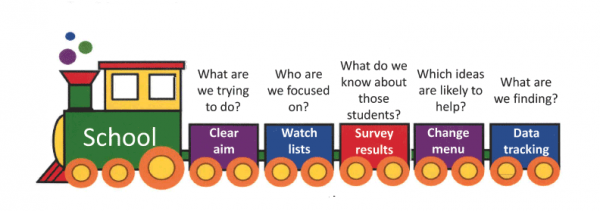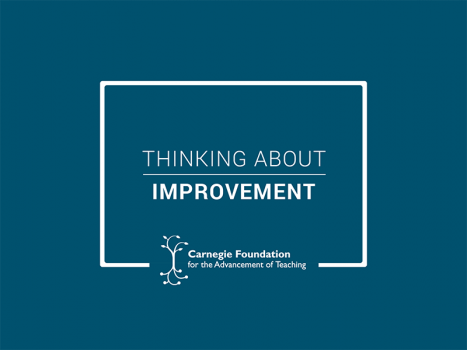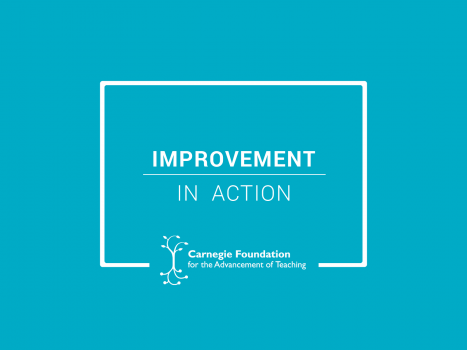Editor’s Note: The Carnegie Foundation’s fourth annual Summit on Improvement in Education takes place March 27-29, 2017. Over the course of three days, teachers, school and district leaders, researchers, foundations, and innovators will discuss their successes and challenges, and offer tools and tips related to effective school change. This is the third post in a series discussing key insights and reflections from Summit presentations.
The idea of a teacher entering a classroom, shutting the door, and teaching in whatever style or method feels comfortable is going the way of the one-room schoolhouse. Years of rigid accountability have rendered that degree of teacher autonomy an anachronism, and it will stay that way. Even as the new federal government eases off its predecessor’s regulatory grip, many schools are metaphorically sticking with the open classroom door policy. Evaluations of school reforms have found that when teachers, administrators, researchers, and other education experts collaborate on improvement work within structured networks, students do better.
“You have all of these minds coming together with their best resources and their best ideas, testing them to see if they’re working or not working, and then helping each other make them better,” said Michele Savage, the principal of Shue-Medill Middle School in Newark, Delaware.
Savage knows from experience that taking a network from inception to a high level of functioning is a heavy lift. It requires expanding the group while also keeping current members engaged, and continually building proficiency in the technical aspects of improvement work, such as understanding how to use data. Shue-Medill along with Milford Central Academy, also a Delaware middle school, have been doing this work for the past three years within two networks that overlap in part like a Venn diagram, Schools That Lead and Carnegie’s Student Agency Improvement Community (SAIC), funded by the Raikes Foundation. Savage and Milford principal Nancy Carnevale will describe in detail how these networks function, the benefits, and the role teachers play, during a session at the 2017 Carnegie Summit on Improvement in Education.
Accelerate Learning Through Networked Communities
The short story is that Savage and Carnevale both became principals of their middle schools at the same time. Both schools have about the same number of students — between 850 and 950; both are fairly well balanced by race, ethnicity, and income; and both were sending too many unprepared students to high school. One out of six graduates of Milford Central Academy failed 9th grade; the failure rate for Shue-Medill graduates was one out of five — or 20 percent.
Carnevale was already involved with Schools That Lead when she joined SAIC in order to participate in that network’s growth mindset activities aimed at teaching skills and strategies to students that help them to do better in school and to start seeing themselves as good learners. Savage got involved because, as a first-year principal, she wanted advice on where to begin to make improvements. The two women became fast friends and colleagues, and mind readers. When talking about what the networks have done for their schools, they finish each other’s sentences and, at one point, even answered a question at the same exact time, using the same exact words.
The other SAIC members helped them identify the underlying problems preventing some students from learning — absenteeism, discipline issues, and instruction — and then provided guidance on potential solutions based on their own research and experience. Because networks have experts from all walks of the education field, from teachers and administrators to researchers and design experts, Carnevale says she and her teachers now have an entirely different relationship with research and researchers. In the past, “you would wait for this research to shower down on you and then you would do it,” said Carnevale, raising her arms over her head and pantomiming falling rain). Now, the relationship is give and take; teachers share their results with the researchers, who then help the teachers analyze the data, and together, they discuss what to do next.
Even the smaller scale partnership between the middle schools (a third Delaware middle school recently joined School That Lead) has strengthened their efforts by inspiring innovation and accelerating the process. Teachers have different strengths and there are more of them to test variations of a change idea. For example, teachers at Shue-Medill use a successful plan developed by a teacher at Milford for student-led classes on days when they have substitutes. Meantime, Milford teachers have access to a Shue-Medill teacher’s adaptation of a program called Request to Retest that showed the best results for students of all the versions tried at the two schools.

Three Guiding Principles of Network Engagement
This degree of trust and mutual respect doesn’t occur spontaneously. Like any other relationships, those within networks take time, understanding of each other’s professional practices, and, often, a bit of a motivational assist.
“We’ve done a lot of thinking and iterating over the past few years around what it really takes to engage practitioners in continuous improvement,” said Lucy Herz, the co-founder and program director of the Student Success Network (SSN), who will be discussing network engagement at the Summit session with Carnevale and Savage. SSN is comprised of 50 education and youth development organizations committed to helping low-income students in New York City acquire the social and emotional skills needed to succeed in college and in life.
Herz said they are guided by three principles in growing and strengthening their network: empowering individuals, meeting people where they are, and building social relationships.
To empower network members, SSN borrows from the proverb that if you give a man a fish you feed him for a day, but if you teach him to fish you feed him for a lifetime. “We think a lot about what are the tools and the skills and the mindsets that our members need to be able to really own the work [of continuous improvement],” explained Herz.
Meeting people where they are requires paying close attention to someone’s needs and knowledge and finding a comfortable fit. Herz says they work with people at all levels of experience from executive directors to frontline staff and “with people who are really well versed in using data and also people who are skittish about data.”
The third principle is also the most critical to the success of a network, said Herz. Strong social relationships motivate people to build a culture of openness and a willingness to change and work together toward an improvement goal. One way SSN tries to do this is by having two tracks of engagement for members. The SSN Innovates Fellowship, a deep dive into improvement science, occurs in a yearlong program for 11 people nominated by their executive directors. Fellows make a commitment to attend regular meetings, to use their knowledge and resources to lead improvement project in their organizations, and to serve as a support system for each other.
What they refer to as the Improvement Science for All program are groups that members can join that focus on a specific issue, such as attendance problems or improving students’ interpersonal skills. Members still work collaboratively in these groups to identify and test change ideas, but with a little less intensity. Still, it raises a question for SSN about how to find the right balance between rigor and engagement. “We’re trying to hone in on that sweet spot,” said Herz, “that’s a question that we’re grappling with that I imagine a lot of folks are as well.”
The principals in Delaware fall into the deep dive category. Savage has found in the networks the encouragement to keep moving forward with improvement work even in challenging times, and says it’s allowed her to do “some of the best work that I’ve ever done in my educational career.” Carnevale credits SAIC with keeping her on the job. She was preparing to retire and had even told people at work about it, but changed her mind after attending a SAIC workshop. That’s where she connected with Savage and gained renewed excitement and value and realized “that I’m not just working in Milford, Delaware, but I’m part of a much bigger push, a much bigger movement in this country.”
March 2, 2017
When the Kentucky Department of Education wanted a strategy to significantly increase the number of high school students prepared for college and/or careers, it turned to deliverology, a method used by British Prime Minister Tony Blair to make good on his campaign promises.
March 8, 2017
A broad collaboration of stakeholders, from teachers and administrators to researchers and designers, is a key element of design-based implementation research, a school change approach illustrated by an effort to improve genetics instruction from kindergarten to high school.







